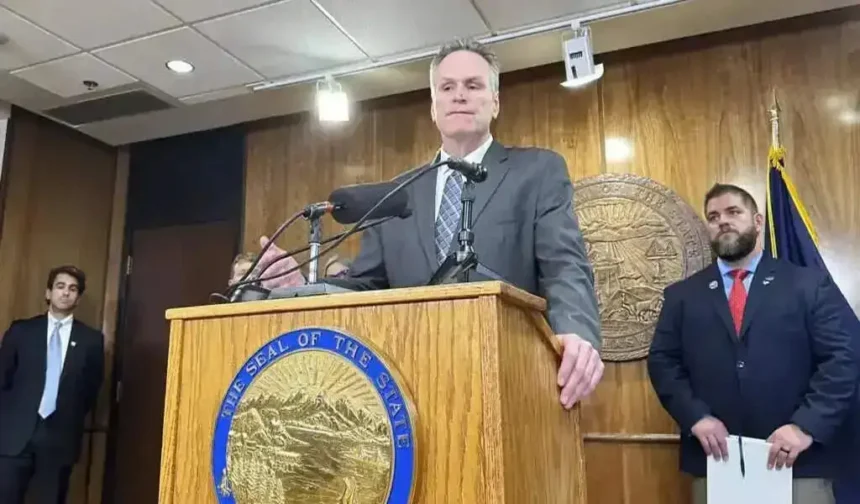(CTN News) – Alaska Republican Governor Mike Dunleavy remarked after Trump’s reelection, “happy days are here again.”
He characterized Trump’s energy strategy as “Christmas every day” for a state that relies significantly on oil.
Trump’s nearly three months in office have been tumultuous, eliciting apprehensions regarding the government budget and generating unease among Alaska’s substantial federal workforce.
Due to intermittent tariffs and a decrease in oil prices, Alaska legislators are compelled to build an annual state budget contingent upon variable oil prices, which has heightened apprehension. Prior to the expiration of Trump’s tariff moratorium for several nations.
The parliamentary session concludes in mid-May.
Prolonged debates on the allocation of funding towards education or other initiatives, instead of the annual oil-wealth fund disbursement received by most Alaskans, have intensified due to the backlash.
Legislators have spent billions from reserves to address persistent budget deficits and have shown little interest in raising taxes to address the deficit. While collaborating with two Republicans, Democrats, and independents, House Speaker Bryce Edgmon stated, “We are all in a predicament.”
Alaska has experienced fluctuations in the energy markets. The government decreases expenditure or closes facilities during price declines; it amplifies investments in infrastructure and other initiatives during price increases. Legislatures assess expenditures by employing revenue forecasts that are revised biannually, contingent upon projections for economic output and oil prices.
Last year, the price of a barrel of North Slope oil was approximately $90. Prior to Trump’s 90-day tariff deferment, it decreased to $65 this week after stabilizing in the low-to-mid-$70 zone last autumn.
The independent Legislative Finance Division reports that the state generates $35 to $40 million for each dollar increase in energy expenditures. The revenue projection for March was predicated on a 2018 fiscal year crude oil price of $68 per barrel, which was $2 lower than the price in December.
Dunleavy spokesperson Jeff Turner stated that the promises of OPEC+ countries to augment output may lead to a decrease in oil prices due to their inherent volatility.
The governor’s primary issue is Trump’s executive order to augment oil and gas extraction, logging, and mining in Alaska. Turner saw it as “beneficial to have an administration that endorses Alaska’s responsible resource development.”
Political leaders in the states anticipate that Trump’s imposing tariffs will persuade South Korea, Japan, and Taiwan to get gas from Alaska’s extensive liquefied natural gas facility or to invest in it. Notwithstanding Trump’s accolades, the project has been stagnant for years due to challenges related to cost, competition, and economic feasibility.
In November, Trump secured a victory in Alaska.
Alongside oil production, Alaska’s sovereign wealth fund also generates revenue. While the principal of the fund remains secure, profits are distributed. Legislators limit withdrawals to a fraction of the fund’s average market value over a five-year span.
Annual dividends derived from profits have been allocated to residents. The distribution of income has been a subject of contention since legislators commenced using earnings to fund state services in 2018.
Dunleavy proposed a disbursement of $3,800 per individual, amounting to a total expenditure of $2.5 billion, or two-thirds of the current year’s revenue. He suggested financing the gap with public cash. This amount is analogous to a strategy that legislators dismissed years prior as financially impractical.
Legislative leaders are dissatisfied with the current strategy as they are receiving calls for augmented financing for K–12 education, exacerbated by escalating healthcare, energy, and inflation costs. Proponents of education want the government to resolve a maintenance backlog that has resulted in structural problems and fungal growth in specific institutions.
Last year, residents collected $1,702 in assistance and energy dividends. The value of the energy relief dividend check has fluctuated over the past five years, from $992 in 2020 to $3,284.
House Majority Leader Chuck Kopp, a Republican, asserts that legislators should not “even encourage the illusion” of Dunleavy’s profit.
“We cannot disburse an unsustainable dividend, as it misrepresents our current fiscal reality,” he asserted. “Do we need supplementary revenue, or is it more crucial to ascertain the magnitude of the dividend we are disbursing and to accurately establish our prioritization?”
A contingent of nonpartisan senators has endorsed oil tax amendments to augment revenue, notwithstanding the absence of broad support.
SOURCE: AP
SEE ALSO:
Bill Maher Reveals Trump Wasn’t What You Saw on TV at the White House Meeting.
Thailand’s Immigration to Launch Digital Arrival Card System May 1, 2025
Siemens Ceo and his Family Identified in Deadly Hudson River Helicopter Crash

Salman Ahmad is known for his significant contributions to esteemed publications like the Times of India and the Express Tribune. Salman has carved a niche as a freelance journalist, combining thorough research with engaging reporting.












